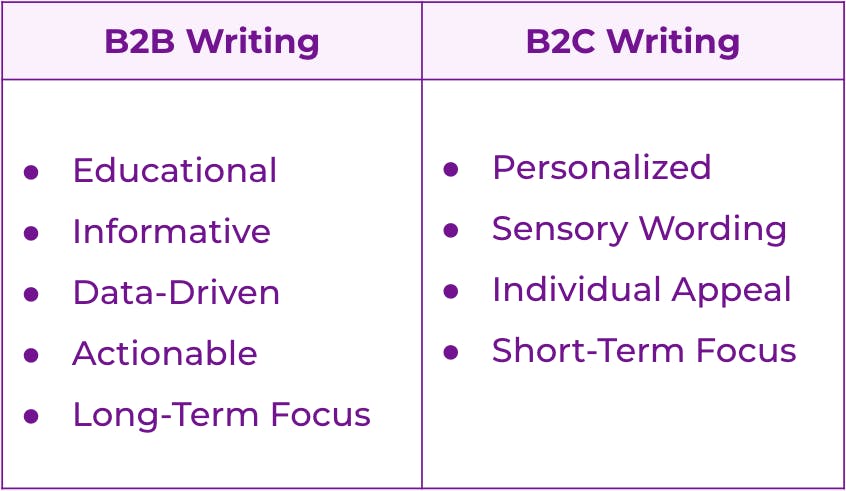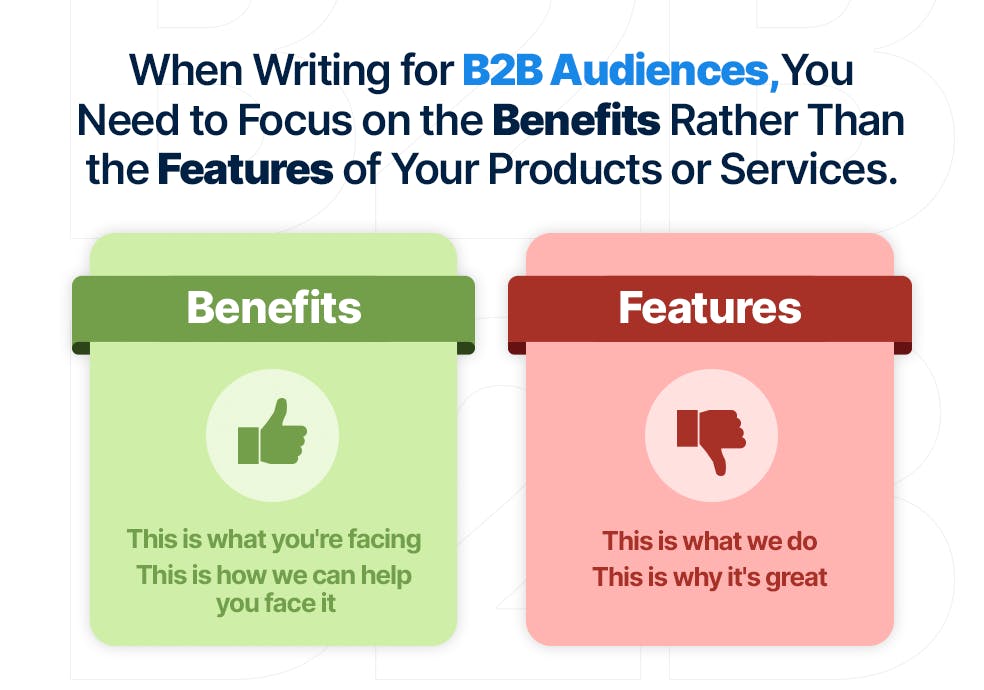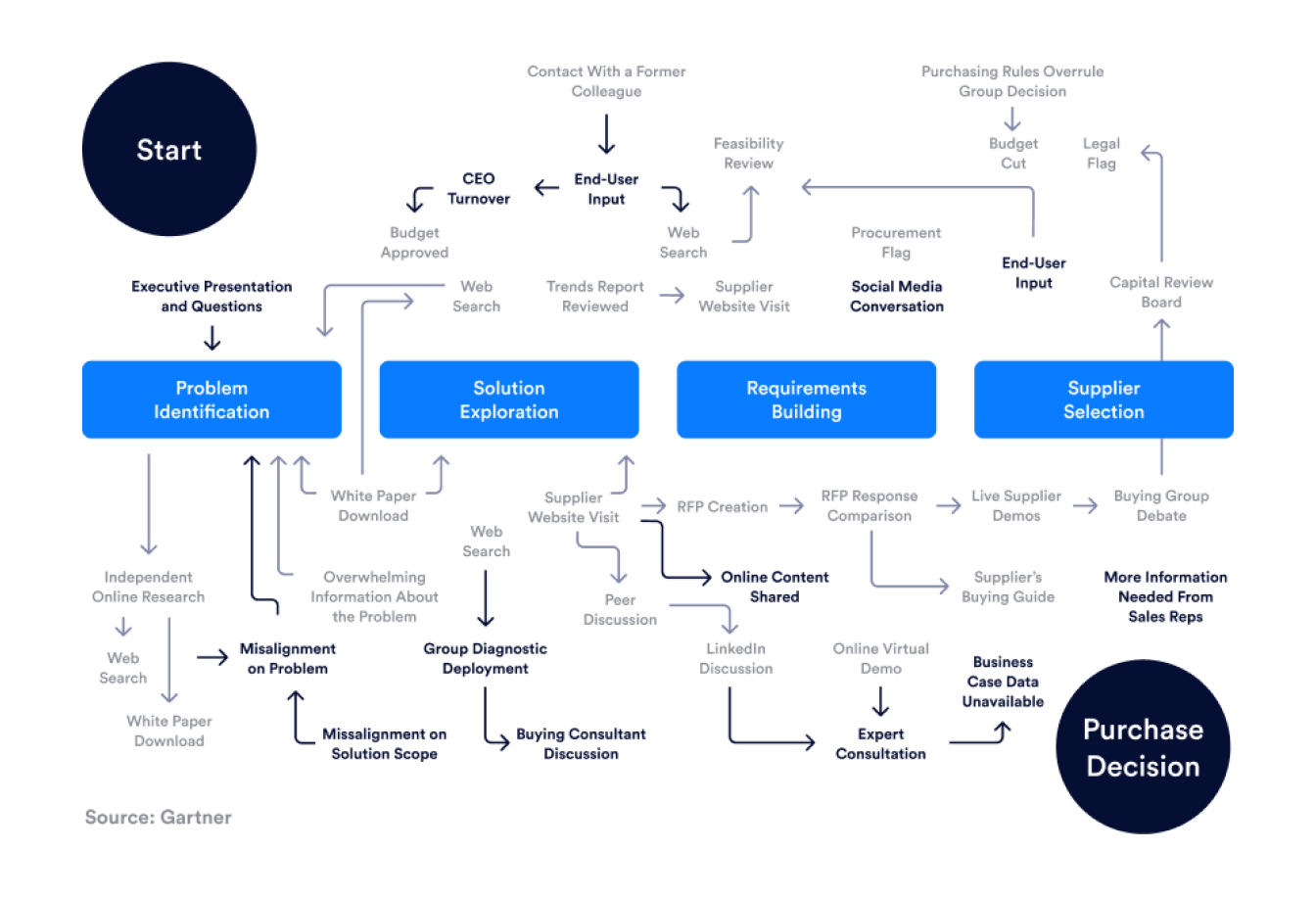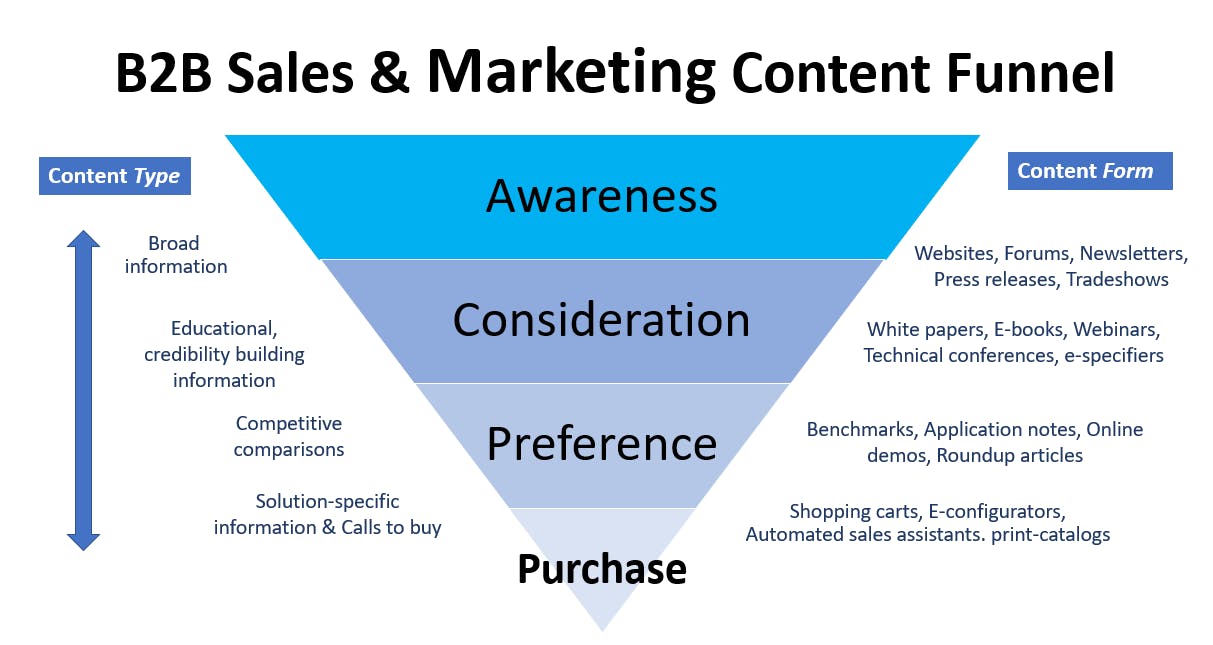B2B Copywriting: Practical Strategies and Examples
Mar 7th, 2024

Copywriting is critical for companies of all sizes across various industries, whether established enterprises or startups. Every company uses marketing content to advertise its brand.
When it comes to B2B copywriting, the emphasis is on addressing specific needs and solving the unique problems businesses face. This specialized type of copywriting is tailored to engage key decision-makers, often within the corporate landscape. B2B copywriting goes beyond the consumer-centric approach, delving into specifics of industry terminology, complex solutions, and distinctive value propositions that resonate with businesses.
By focusing on B2B copywriting, a company can draw new customers, increase retention rate, and develop a reputation as a reliable and influential source of information. In essence, B2B copywriting is a strategic tool for companies looking to attract new B2B clients and foster lasting partnerships built on trust and mutual benefit.
What is B2B copywriting?
B2B copywriting, or business-to-business copywriting, is a type of writing focused on creating compelling and convincing content for businesses targeting other companies as potential clients. The goal of B2B copywriting is to effectively convey a product or service's value proposition while considering business professionals' unique needs and objectives.
B2B copy may include white papers, ebooks, case studies, technical documents, and other in-depth content that helps company leaders make purchasing decisions. Since business-to-business transactions are typically complex and include lengthy sales cycles, B2B copy appeals to people involved in the buying process. Moreover, B2B copywriting provides informative content, encouraging long-term relationships between a business and its clients instead of pushing for an immediate sale.
The key to successful B2B copywriting is understanding the audience, industry trends, and competitive landscape. B2B copywriters must emphasize a product's long-term benefits and ROI, as businesses often make decisions based on the potential impact on their profitability and overall operations.
In contrast to B2C copywriting, where a prospect can make a purchase right away, B2B copywriting aims to persuade several decision-makers at different stages of the process. Let us look at other differences and similarities between B2B and B2C copywriting.
B2B vs B2C copywriting
B2C copywriting, or business-to-consumer copywriting, is the process of creating written content that aims to persuade and engage individual consumers to promote a product or service.
There is a widespread opinion that B2B copywriting should be technical or sophisticated, while B2C copy should be brief, entertaining, and captivating. However, consider the typical B2B customer navigating countless blogs and ebooks filled with technical jargon. Even if they understand the terminology, dull and monotonous copy will bore and confuse them.
Therefore, it is crucial to remember that both B2B and B2C involve communication with real people. Regardless of the audience, the objective of convincing copy is to persuade and motivate the readers to take a specific action, such as buying a product, signing up for a service, or educating the customers about a topic.

While simple language and humor are essential in both types of copywriting, there are some differences in the purpose of the content. Unlike B2C writing, which frequently aims to evoke emotions, B2B writing typically demonstrates the value and practical use of the product or service. The focus shifts from arousing emotions to delivering clear, rational explanations that resonate with the needs and challenges of the businesses involved.
In addition, the channels and platforms for B2B and B2C copywriting can differ. B2B copy is commonly found in white papers, industry reports, emails, and targeted content on professional platforms. B2C copy, on the contrary, is frequently seen in advertising, social media, and product descriptions on e-commerce websites. Understanding these differences is crucial for copywriters to tailor their messaging effectively, ensuring that it addresses the specific needs of either businesses or individual consumers.
Further, we'll explore the most successful strategies and approaches that will help create effective B2B content.
B2B copywriting strategies
Before diving into the strategies, it's worth noting that the most crucial aspect of copywriting is understanding your audience well. In B2B, your readers are often well-informed and business-savvy. To build a strong connection with these people, it's essential to create copy that not only acknowledges their expertise but aligns with their goals. Once you've established this foundation, you can delve into other effective strategies for B2B marketing.
Emphasize benefits over features
While it's crucial to convey the unique features of your product or service, B2B audiences are interested in the benefits these features bring to their business. Thus, you should explain the value your product or service provides. Highlight how your offering can solve their problems, improve efficiency, and increase profit. Demonstrating a return on investment is a persuasive approach that works well in the B2B space.

Back up your claims with relevant data, case studies, testimonials, or any other forms of evidence. B2B buyers are more likely to be persuaded by tangible facts and real-world examples that demonstrate the success of your product or service. Furthermore, to build credibility, provide valuable content, such as a blog post offering strategies for improving B2B conversions. Remember, the best way to emphasize your brand’s value is by always putting the customer first.
Position your brand as an authority
Establish trust through thought leadership by sharing valuable insights and expertise. Develop content that goes beyond promoting your products or services. Create white papers, case studies, and blog posts that demonstrate your knowledge. Once B2B buyers perceive you as a thought leader, they will trust your recommendations and consider your offerings reliable solutions.
Thought leadership extends beyond one-way communication. Engage with your audience through social media, webinars, and industry events. Participate in conversations, respond to comments, and actively seek out discussions related to your field. This engagement develops a sense of community and allows you to address specific questions or concerns.

Create compelling headlines
In a world where people have short attention spans, it's critical to evoke interest in your audience fast. Busy B2B professionals often scan content. Capture their attention with strong headlines and subheadings that convey key messages. Make it easy for readers to understand the main points of your copy quickly.
The headline sets the tone and style of your content, playing a crucial role in informing readers about what they can expect. Creating a captivating headline involves considering several strategies. Firstly, communicate the unique selling proposition to keep your audience engaged and motivated to read further. Ask a question that positions your product as the solution. Consider using a call to action. Finally, make sure your headline is concise and communicates what you offer.
Use data and statistics
B2B buyers are often data-driven and analytical. Incorporate relevant data and statistics to support your claims and highlight the advantages of your product. Ensure the data is accurate, up-to-date, and corresponds to your key messages. This approach adds credibility to your copy and resonates well with a B2B audience seeking evidence-based decision-making.
When including data and facts in your content, consider creative ways to turn them into a captivating story. It will help increase audience engagement and make a lasting impression on your readers. Regardless of the data format, cite reputable sources for credibility. Include source links or references at the bottom of the page to demonstrate the thoroughness of your research and emphasize that your business strategy is grounded in facts.
Address objections
B2B buyers often enter the decision-making process with a list of concerns or hesitations, ranging from cost considerations to implementation challenges. You demonstrate transparency and build trust with your audience by identifying and addressing these objections within your copy.
One effective strategy is directly integrating objection handling into your content through a dedicated section. For example, if cost is a common objection, highlight the long-term value and return on investment your solution provides. Use case studies and real-world examples to showcase how other businesses overcame similar objections and succeeded with your product or service.
In addition, consider creating targeted content, such as FAQ sections or objection-specific blog posts, to delve deeper into these concerns. This not only positions your brand as proactive in understanding your audience but also provides a resource that potential clients can reference at various stages of their decision-making process.
Optimize for search engines
In the B2B space, decision-makers often turn to search engines to find solutions to their problems. Conduct thorough keyword research to identify terms and phrases that are relevant to your B2B industry. Understand the specific terms your audience will likely use when searching for products or services. Integrate these keywords naturally into your copy, including headings, subheadings, and the body of the content. However, avoid keyword stuffing, as it can diminish the quality of your writing.
Search engines often prioritize comprehensive, evergreen content. Create content that remains relevant over time, as this can contribute to sustained organic traffic. Implement a strategic linking strategy within your content. Internally link to other relevant pages on your website to guide users to additional valuable information. In addition, include external links to reputable sources within your industry.

Include calls to action
B2B copywriting should guide the reader toward a specific action. Whether it's downloading a white paper, scheduling a demo, or making a purchase, your calls to action should be clear, compelling, and aligned with the objectives of your B2B audience. Communicate the next steps you want your readers to take, making it easy for them to move forward in the buyer's journey.
Your CTAs should be crystal clear and concise. Use language that leaves no room for ambiguity, letting your audience know exactly what action you want them to take. Whether it's Request a Quote, Download the Guide, or Contact Us, the language should be direct and compelling.
Consider the natural flow of your content and strategically position CTAs at points where the reader is likely to be motivated to take action. This might be after presenting a key benefit, showcasing a success story, or addressing a pain point.
Remember, successful B2B copywriting requires a balance between professionalism, clarity, and a persuasive narrative that speaks directly to the needs of your target audience.
B2B copywriting examples
Now, we will provide four examples of B2B copywriting and demonstrate how they effectively engage audiences, convey key messages, and ultimately contribute to achieving business objectives.
IBM Cloud Services
IBM's copywriting for its cloud services landing page stands out due to its clarity and focus on solving specific business challenges. The copy doesn't overwhelm the reader with technical jargon but instead highlights critical benefits such as scalability, security, and seamless integration.
Using concise and compelling language, IBM effectively communicates how its cloud services can streamline operations and drive business innovation. Customer success stories further add credibility, demonstrating real-world applications and outcomes.
Monzo Business Banking
Monzo Business Banking is an example of effective B2B copywriting because of the clear and precise presentation of key information. The headlines are attention-grabbing and convey the value proposition. Subheadings break down complex topic into digestible sections. The content communicates the main benefits of the business banking services.
Bullet points and lists highlight the features of the business banking services. The B2B copy explains how the services solve specific problems and meet the needs of businesses. FAQ section anticipates common questions, addresses potential concerns, and provides answers. Moreover, high-quality images and other visuals complement the text and enhance understanding and engagement.
Airbnb Business Travel
Airbnb Business Travel aligns its messaging with the overall brand, ensuring a seamless transition from a consumer-focused platform to a business-centric one. Furthermore, Airbnb highlights unique, comfortable, and inspiring places to stay, demonstrating their difference from traditional, mundane business travel.
Airbnb's B2B copy describes how their accommodations contribute to productivity and creativity during business trips. It involves features like dedicated workspaces, unique venues for team-building, and comfortable environments that foster a positive work mindset. In addition, the company emphasizes its commitment to safety and excellent customer service, particularly for business clients.
Squarespace SuperBowl ad
Squarespace has unveiled its ninth Super Bowl campaign, The Singularity, featuring acclaimed actor Adam Driver. The video mocks Squarespace's origins while highlighting its transformation into a comprehensive platform meeting diverse business needs. The campaign highlights Fluid Engine, the latest platform innovation from Squarespace. Fluid Engine is a next-generation website design system that provides a fast, easy-to-use, personalized web design experience.
Squarespace, originally a website builder, has evolved into an all-in-one platform supporting entrepreneurs in building and growing their online presence, connecting with audiences, monetizing content, and managing business operations. Notably, behind the entertaining video lies B2B copy strategically crafted to communicate with businesses, addressing their specific needs. It showcases Squarespace as a valuable tool for enhancing online presence, streamlining operations, and driving measurable business growth.
These examples highlight the diversity in B2B copywriting approaches, ranging from storytelling and case studies to educational content. Each strategy is tailored to the audience’s unique needs and preferences of the audience and aims to establish trust, demonstrate value, and drive engagement. You develop effective and impactful copywriting strategies by analyzing and drawing inspiration from these copywriting examples.
